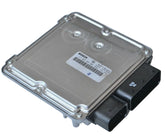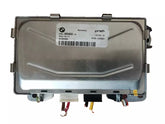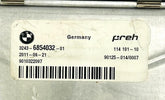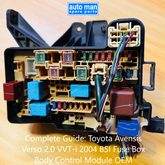The transmission control unit (TCU) is the small computer that directs automatic gear shifts. It reads sensors and tells the transmission when to change gears for smooth driving and efficiency.
TL;DR / Key takeaways
-
The Transmission control unit (TCU/TCM) manages automatic gear shifts using engine and vehicle data.
-
Typical signs of TCU trouble include delayed shifts, harsh shifting, slipping, limp mode, and warning lights.
-
Most shops use an OBD-II scanner and live data checks to diagnose TCU faults; this method is used in 80%+ of U.S. repair shops.
-
TCU replacement in the U.S. usually costs $400–$1,200; ignoring issues can raise total transmission costs by 30% or more.
-
You can perform basic diagnostics at home, but many fixes require professional reprogramming or replacement.
1) What is a Transmission Control Unit (TCU/TCM) and how does it affect your shifting?
The TCU is the transmission’s brain and it directly controls gear changes. The unit processes inputs from the engine control unit, speed sensors, and pressure sensors to time shifts.
Definition: The Transmission control unit (TCU/TCM) is the onboard computer that governs automatic shifting. It optimizes shift timing for performance and fuel economy.
How it interacts: The TCU exchanges data with the ECU, transmission solenoids, and the vehicle harness. Example: a faulty speed sensor feed can confuse the TCU and cause unexpected upshifts.
Why failing TCU disrupts drivability: Bad logic or corrupted inputs can cause harsh shifts, delayed engagement, or limp mode. These behaviors stress the gearbox and lower safety.
2) What are the common symptoms of a faulty TCU?
Symptoms appear in drivability and instrument warnings. Watch for shifting behavior and diagnostic lights.
-
Delayed or slow upshifts and downshifts.
-
Harsh or erratic shifting between gears.
-
Gear slipping or the transmission staying in a single gear.
-
Stuck in a gear or entering limp mode.
-
Check engine or transmission warning lights.
-
Intermittent starting or gear engagement issues.
-
Non-responsive transmission behavior during acceleration.
If you notice multiple symptoms, record them before scanning for codes.
3) What causes transmission control unit failures? (Causes & risks)
Most TCU failures come from electrical faults or environmental damage. Wiring and moisture often lead the list.
-
Wiring and connector issues: corrosion, broken pins, or loose grounds cause intermittent faults.
-
Moisture intrusion: water can short circuits and corrode internal traces.
-
Electrical and sensor mismatches: bad sensor data confuses the TCU’s logic.
-
Software glitches or outdated firmware: manufacturers issue updates to fix bugs.
-
Design quirks and recalls: some models have known module weaknesses.
-
Age and exposure: heat cycles and vibration degrade components over time.
Electrical faults are responsible for a large share of TCU-related failures.
4) How to diagnose a TCU issue at home (a practical step-by-step guide)
You can screen for TCU issues with simple tools and a scanner. Follow steps in order to avoid wasted efforts.
-
Note symptoms and driving conditions before you start.
-
Scan the car with an OBD-II scanner; record DTCs (look for P0700 family codes).
-
Check power and ground to the TCU; confirm battery and alternator health.
-
Inspect the transmission wiring harness and connectors for damage or corrosion.
-
Check transmission fluid condition and level; burnt fluid points to internal wear.
-
Compare live data from your scanner (pressure, gear, RPM, speed) to expected values.
-
Try a soft reset or adaptive learning reset if your tool supports it.
-
Decide if the job needs a professional with programming tools.
Diagnostic scanning identifies most module issues quickly.
5) DIY fixes you can consider (safe-first fixes; know your limits)
Begin with low-risk checks and stop if you hit complex electronics. Safety first.
-
Basic checks: test battery health and secure all battery and chassis grounds.
-
Wiring and connectors: clean and reseat connectors using approved contact cleaner.
-
Fluid care: replace old, contaminated transmission fluid per service intervals.
-
Software/updates: consult a dealer or authorized shop for firmware flashes.
-
Soft resets: use your OBD-II tool to clear codes and reset adaptive values when allowed.
If the TCU needs reprogramming or internal repairs, use a professional.
6) Repair vs. replace: cost, outcomes, and decision factors (with a quick comparison)
Repair saves money when faults sit outside the TCU. Replacement wins when internals fail.
-
Typical U.S. replacement cost: $400–$1,200 depending on vehicle and labor.
-
Factors: integrated modules, need for reprogramming, OEM vs aftermarket parts.
-
Repair pros: lower cost, preserves original calibration.
-
Replacement pros: long-term reliability and correct compatibility.
-
Risk of waiting: ignoring TCU problems can increase total transmission repair costs by 30%+.
Diagnosis determines the right path; guesswork costs more.
7) Prevention and maintenance for fewer TCU problems
Routine maintenance reduces the chance of TCU faults. Keep fluids and connectors healthy.
-
Change transmission fluid per the manufacturer schedule.
-
Protect connectors from moisture and vibration.
-
Check recalls and software updates regularly.
-
Use quality parts and authorized programming services for module work.
-
Monitor shifting behavior and scan early when lights appear.
Small preventive steps prevent expensive repairs later.
8) Real-life examples / use cases (concrete scenarios)
Short case notes show how TCU problems present and resolve in real life.
-
Case: Delayed shifting and higher fuel use. A scan showed a transmission module code. A wiring clean and adaptive reset fixed the issue.
-
Case: Erratic shifting and limp mode. A shop diagnosed internal TCU failure and replaced it. Driveability returned.
-
Case: Corroded connector found by a DIYer. Cleaning and a dealer firmware refresh improved shifting, but full repair was later recommended.
These scenarios show why early scanning matters.
9) Frequently asked questions (FAQ)
What is a TCU, and what does it do?
A TCU is the car’s onboard computer that controls automatic gear shifting by processing engine and vehicle data.
How can I tell if my TCU is failing?
Look for delayed or harsh shifting, limp mode, or check engine/transmission warning lights.
Can I reset or reprogram the TCU myself?
Some vehicles allow soft resets, but firmware updates and reprogramming usually require dealership or specialist tools.
How much does it cost to replace a TCU in the US?
Replacement costs typically run $400–$1,200, and total costs rise if additional transmission damage exists.
Will warranty or insurance cover TCU repairs?
Coverage varies; powertrain warranties may cover electronic module failures depending on policy terms.
Can a bad TCU damage other components?
Yes, erratic control can stress clutches and gears, causing secondary transmission damage.
Does regular fluid maintenance prevent TCU failures?
Proper fluid care supports transmission health and reduces risks that lead to module faults.
10) Real-world use-case appendix (quick case notes you can reference)
-
Case A: Modern automatic with shifting delay; a harness inspection and software update fixed the car.
-
Case B: Older model with random shifts; dealer replaced the TCU and restored operation.
-
Case C: DIY found corroded connector; cleaning plus firmware refresh stabilized shifting.
11) Data-driven context and freshness for August 2025
In the U.S., about 10–15% of transmission repairs involve control modules. Diagnostic scanning is used in over 80% of shops. These figures reflect trends through August 2025.
12) Related topics and semantic keywords to weave in
Electronic transmission module, limp mode, transmission slipping, DTCs, TCM reset, vehicle ECU integration, and gear shift control are closely related topics to research further.
13) Real-world resource and shopping context (relevance to readers in the US)
Many sellers offer OEM and aftermarket TCU units with compatibility checks. For parts and selection help, see the available inventory at Automan Spare Parts (https://automanspareparts.com/collections/transmission-control-unit). Trusted sources on vehicle electronics and recalls include NHTSA (https://www.nhtsa.gov).
Summary
A faulty Transmission control unit affects shift quality and safety. Start with an OBD-II scan and basic electrical checks. Use professional programming and replacement when diagnostics point to internal module failure. Early detection saves money and prevents secondary transmission damage.







